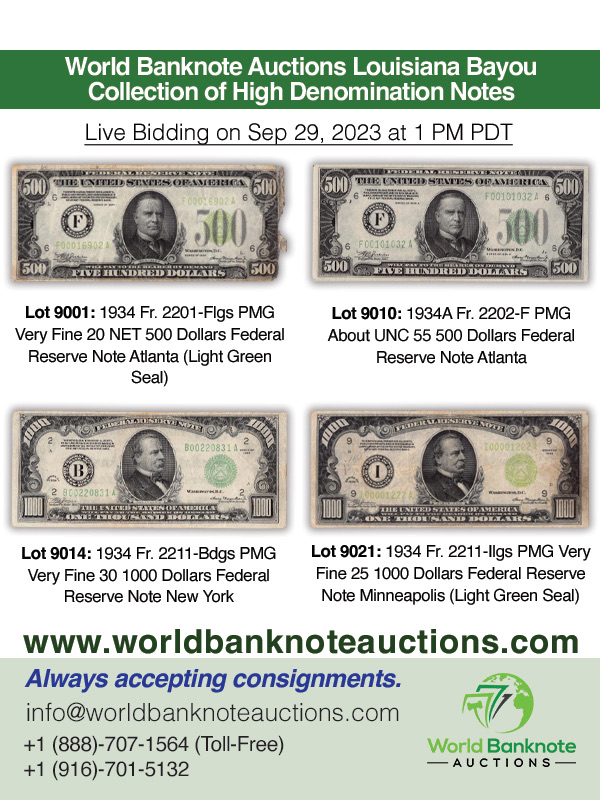
PREV ARTICLE
NEXT ARTICLE
FULL ISSUE
PREV FULL ISSUE
VOCABULARY TERM: OBVERSEHere's a cornerstone entry from Dick Johnson's Encyclopedia of Coin and Medal Terminology - the definition of "Obverse". -Editor Obverse. The side of a numismatic item bearing the principal design or device; the side opposite the reverse. A number of design and technical factors determine which side of a two- sided numismatic or medallic item is the obverse, these are listed below. Design Factors Determining Obverse (1) Most often the obverse is the side bearing a portrait; in countries with a monarch, the featured ruler's head or bust appears on the obverse. (2) On United States coins the obverse is the side bearing the date irrespective of any other devices; U.S. statues state arbitrarily the definition of the obverse is the side bearing the date. (Some commemorative coins do not adhere to this requirement, however.)
(3) In some art medals which may not have a single principal device the obverse is determined as the side with the greatest relief (and reverse, the least relief); or should a medal be domed on one side and flat or concave on the other, the obverse is the domed side, as if it would lie flat on the one and would (4) In nonrepresentational art without device or obvious important side, the obverse is either side the artist so states.
(5) For military decorations writer John Horsley Mayo states there is a precise rule: Technical Factors Determining Obverse (6) In ancient times the obverse was the PILE or anvil position (lower position when struck). This has some validity even today, as art medals with high relief are struck with the die of greatest cavity in the lower position in a press; thus this is the obverse. (7) Medallic items which must be trimmed after striking (not those struck in a coining press, nor those turned or trimmed on a lathe), but those struck with open face dies, the obverse is created with a rim and the reverse has none. This is for the trimming tool to line up for the center and the edge is trimmed – the reverse has no register. The shearing of the trimming tool leaves a smooth edge on the obverse where it enters the metal but leaves a burr where it exits the metal. Designers believe it is better to have this burr on the reverse (and its subsequent removal evidence) rather than on the obverse. There is somewhat of an unwritten law in numismatics to display or illustrate the obverse above or to the left of the reverse. In Western civilization this is because we read from left to right and the left position is the most important because we notice this first, thus the most important side of the numismatic item is placed to the left to be noticed first. (An exception to this might be a left facing portrait to look toward the reverse design.)
In England, numismatic writer Major Lawrence L. Gordon reports there is a mnemonic device for remembering which side is obverse: Obverse-Reverse Relationship Both sides of a numismatic or medallic item should be considered as separate parts of the same work of art; as a two-panel cartoon, or as a diptych. Thus both sides should be designed by the same artist, created at the same time and with one theme or concept for both sides. The use of a repeated design element on both sides may unify the work and add a touch of charm. These repeated elements include the same or similar borders, a similar size or shaped panel, lettering in the same position or the same type style, any form of design repetition or implication. Other art techniques in designing the obverse and reverse can unify the two sides. Often this is a repeated element, but this can just as well be a contrasting element, similar symmetry, harmony or other art techniques. Also concordant designs unify the obverse to the reverse, and many examples of these exist where the reverse is the back of the obverse as if it were sculpture in-the- round. See concordant.
To read the complete entry on the Newman Numismatic Portal, see:
Wayne Homren, Editor The Numismatic Bibliomania Society is a non-profit organization promoting numismatic literature. See our web site at coinbooks.org. To submit items for publication in The E-Sylum, write to the Editor at this address: whomren@gmail.com To subscribe go to: https://my.binhost.com/lists/listinfo/esylum All Rights Reserved. NBS Home Page Contact the NBS webmaster 
|
